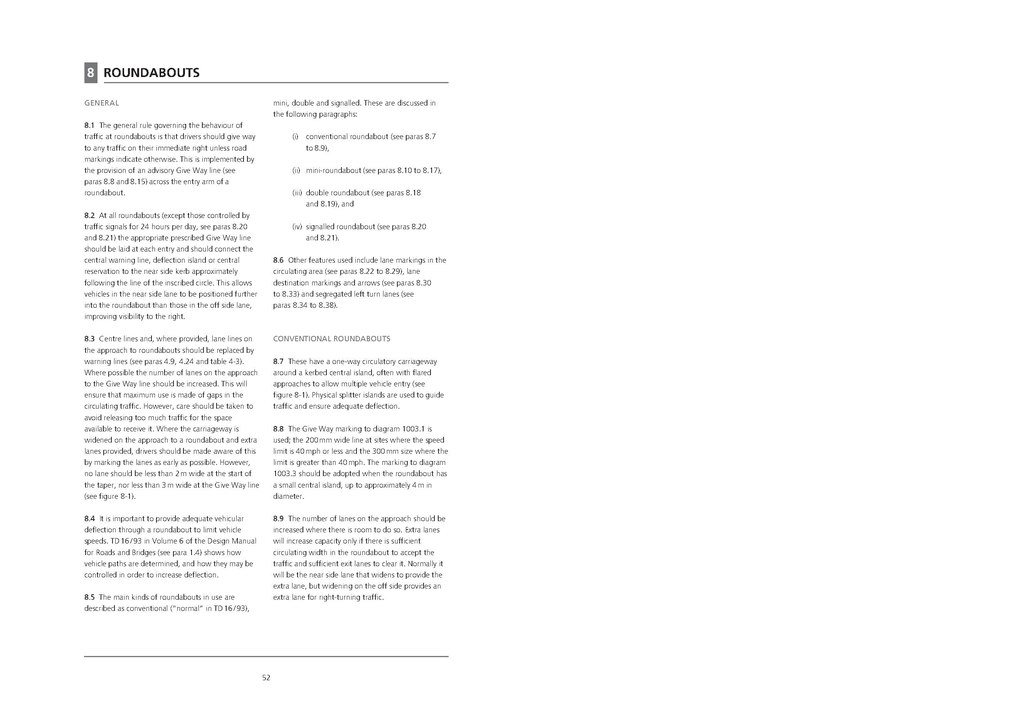8ROUNDABOUTS
GENERAL
8.1 The general rule governing the behaviour of traffic at roundabouts is that drivers should give way to any traffic on their immediate right unless road markings indicate otherwise. This is implemented by the provision of an advisory Give Way line (see paras 8.8 and 8.15) across the entry arm of a roundabout.
8.2 At all roundabouts (except those controlled by traffic signals for 24 hours per day, see paras 8.20 and 8.21) the appropriate prescribed Give Way line should be laid at each entry and should connect the central warning line, deflection island or central reservation to the near side kerb approximately following the line of the inscribed circle. This allows vehicles in the near side lane to be positioned further into the roundabout than those in the off side lane, improving visibility to the right.
8.3 Centre lines and, where provided, lane lines on the approach to roundabouts should be replaced by warning lines (see paras 4.9, 4.24 and table [[Page:UK Traffic Signs Manual - Chapter 5 Road Markings. 2003 (Sixth Impression 2009).pdf/4|#table4.3|4-3). Where possible the number of lanes on the approach to the Give Way line should be increased. This will ensure that maximum use is made of gaps in the circulating traffic. However, care should be taken to avoid releasing too much traffic for the space available to receive it. Where the carriageway is widened on the approach to a roundabout and extra lanes provided, drivers should be made aware of this by marking the lanes as early as possible. However, no lane should be less than 2 m wide at the start of the taper, nor less than 3 m wide at the Give Way line (see figure 8-1).
8.4 It is important to provide adequate vehicular deflection through a roundabout to limit vehicle speeds. TD 16 / 93 in Volume 6 of the Design Manual for Roads and Bridges (see para 1.4) shows how vehicle paths are determined, and how they may be controlled in order to increase deflection.
8.5 The main kinds of roundabouts in use are described as conventional ("normal" in TD 16 / 93), mini, double and signalled. These are discussed in the following paragraphs:
(i) conventional roundabout (see paras 8.7 to 8.9),
(ii) mini-roundabout (see paras 8.10 to 8.17),
(iii) double roundabout (see paras 8.18 and 8.19), and
(iv) signalled roundabout (see paras 8.20 and 8.21).
8.6 Other features used include lane markings in the circulating area (see paras 8.22 to 8.29), lane destination markings and arrows (see paras 8.30 to 8.33) and segregated left turn lanes (see paras 8.34 to 8.38).
CONVENTIONAL ROUNDABOUTS
8.7 These have a one-way circulatory carriageway around a kerbed central island, often with flared approaches to allow multiple vehicle entry (see figure 8-1). Physical splitter islands are used to guide traffic and ensure adequate deflection.
8.8 The Give Way marking to diagram 1003.1 is used; the 200 mm wide line at sites where the speed limit is 40 mph or less and the 300 mm size where the limit is greater than 40 mph. The marking to diagram 1003.3 should be adopted when the roundabout has a small central island, up to approximately 4 m in diameter.
52
